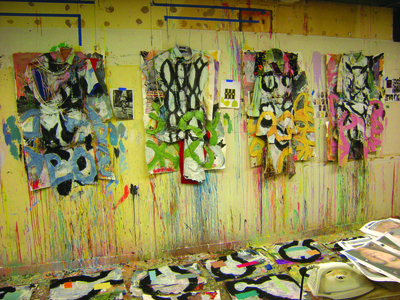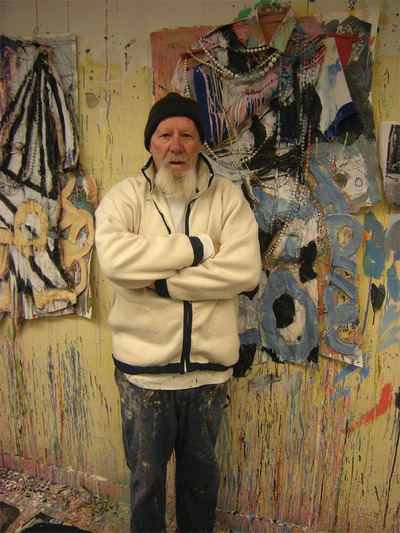Memory’s Costumes: The Arts of Alan Neider

Alan Neider’s Hamden, CT studio.
All the dresses of loss are arranged on the wall of Alan Neider’s studio like a pageant of memories assembled from a carnival flea market. Yet for every bit of their vibrancy, there is a strong note of mortality, and even of violence, attached to them.
“When I finished these pictures and they were hanging and I was living with them for a while,” Neider says, “I realized that somehow they looked like outfits that had been lost in a flood, lost in a hurricane, lost in something, and buried. [Then] at some point in time dug up, found, displayed.” Although his Color Dresses are ”first and foremost paintings” which he wants to be “quite abstract,” and in which he is “dealing with formal issues of paint, transparency, thickness, form, shape, color,” it is also obvious to Neider that there is inherent tragedy here as well. By way of explaining this, he recounts a New York Times story about Hurricane Sandy in which a Staten Island woman who had lost both her husband and daughter in the storm had the wedding dress which had been washed away found and returned to her.
It is clear that whatever importance formal questions have for Alan Neider, the answers to them are not an end in themselves. As he said during my studio visit, “I want these pictures to have some sort of emotional connection, something to do with humanity, something besides formal issues.”

Alan Neider in his Hamden, CT studio.
To Neider, the way to that connection means not being bound to a single medium, but instead producing work that emerges from a conversation between collage, drawing, painting, and sculpture. “Early on,” Neider recalls, “when I was painting in the ’60s and I’m painting, painting, but I wanted some of those images to ‘come out’ so I started building out just totally, completely out of nowhere, just naïve.” The dimensionality of the Color Dresses is not the realism of a body beneath the cloth, but an evocation of how time reshapes the world that art invents. “Frankly, I really like more and more [the way] my things are getting thicker,“ Neider says of these most recent works. “I like the weight of things. If you pick these dresses up, it’s not just a flimsy piece of paper” in your hands.
The artist’s embrace of variety is also reflected in the materials he has chosen to use. Since his 1979 wrapping of the outer columns of Mies van der Rohe’s Dirksen Federal Building in Chicago, animating the structure with what appeared to be celebratory bandages, cloth has been an ongoing part of his project that “definitely ties things together.” Over the past seven years he has used sewing to construct collages not of images, but of fabrics. Stitching in his work is like drawing, another way of making a line. For his first renderings of handbags, along with graphite, tape and charcoal, he began sewing by hand. Yet he didn’t like the effects of the stitching: “It wasn’t doing something I wanted it to do.” He then acquired his first sewing machine, and “started doing drawings and then sewing the drawings and the drawings got bigger and bigger and bigger.”
The Hamden studio mirrors the variety of Neider’s media, with designated spaces for drawing, sewing and painting, all flexible enough to let him build larger-scale installations as well. It took him four years to convert what had been a neighborhood grocery and meat market, with its counters and slicers and walk-in freezer, into the space that he shares with his wife, the photographer Joan Fitzsimmons. When, after its completion three years ago, he first sat down in it and began making drawings, it was a day filled with the excitement of what was to come.

Alan Neider, Dresses & Rings 5, 2010, graphite, charcoal, collage on sewn papers, approx. 35 x 32″. Courtesy of the artist.
Things spill over here, both literally and figuratively, with the history of all the work he has made within the studio so far leaving its traces everywhere. Although he is reluctant to complain, he does admit to a longing for more space. It is, after all, impossible not to regret that some 30 years ago he leased a building in Chicago with three floors for $400 a month.
There are singular advantages to his New England location in a residential neighborhood that embraces what Neider does. “Sometimes people will peek in, which is kind of nice,” he claims. And his garden, just outside the studio doors, also draws local attention. There is another benefit in that he’s “able to work when I want to, living upstairs as opposed to having to get in a car.”
There is a clear sense of satisfaction that, having had “all kinds of situations,” as he describes the arc of his career, Neider now has “made it to where I have the industrial sewing machine” (dating from 1939 and rebuilt by a local expert Neider has befriended) that has become more and more central to his work.
“In some instances,“ as Neider begins to list the values that sewing has for him, “I’m drawing with that line, and it’s also a way of fabricating things, of putting things together, and it’s also relatively unique—not many people put together their surface in that kind of way.” He has recently applied for a grant that he would use towards the purchase of a “long arm” machine that would allow him to “do these big drawings and start to sew in the middle of them” without having to roll them up first.
In regard to future commissions, he has a kind of equanimity about the way things do, or do not, work out. “You get some things, most things you don’t get,” he says, “but some things happen.” And what does happen, of course, is the kind of work that Neider goes on making on his own instructions, redefining the impasto effect of paint with his sewn surfaces and their almost invisible tension. The dresses are meant to be both warnings against accepting what we often allow to vanish, and rejoicings over what we might manage to save. Unlike the monochromatic garments that are found in a number of Anselm Kiefer’s works, where even angels’ robes are dusted with ashes, Neider returns the colors to these lost possessions, and lets them be imagined—as was that bereft woman’s restored wedding dress—as proof of resurrection.
